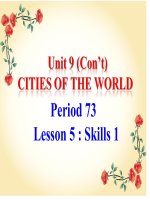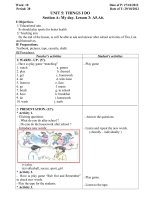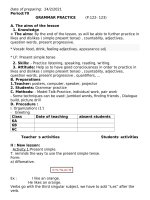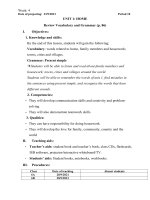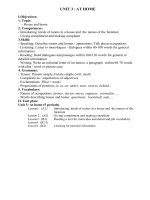KHBD TIẾNG ANH 6 TUẦN 10 TIẾT 28-30 Unit 3 L 2 Pronunciation Practice Speaking; L3 New words +listening; Reading; Speaking
Bạn đang xem bản rút gọn của tài liệu. Xem và tải ngay bản đầy đủ của tài liệu tại đây (313.96 KB, 18 trang )
Week: 10
Date of preparing: 4/11/2021
Period 28
UNIT 3: FRIENDS
Lesson 2.3 –Pronunciation, Practice + Speaking (p. 27)
I.
Objectives:
1. Knowledge and skills:
By the end of this lesson, students will be able to identify the sound changes in
the question: “What are you doing?” and invite a friend out and discuss things to do
together.
Pronunciation: What are you doing …. ?/wɒdəjədu:ɪŋ/
Skills: Speaking, listening, writing, reading
2. Competencies:
- Students can use the knowledge to complete the exercises, practice the
language aspects in communicative situations.
- They will improve their speaking and listening skills
- They will raise motivations and interests in learning English as a foreign
language
- They will develop the competences such as self - control, independentlearning, creativity and problem-solving.
3. Qualities:
- Students are active to broaden and percept the knowledge
- They will have the good attitude to working in groups, individual work, pair
work, cooperative learning.
II. Teaching aids:
- Teacher’s aids: student’s book and teacher’s book, class CDs, flashcards, ISB
software, projector/interactive whiteboard/laptop/TV.
- Students’ aids: Student’s book, notebook, workbook.
III. Procedures:
Teacher’s and Students’ activities
A. Activity 1: Warm-up
Contents
a) Objective: Introduce the new lesson and set the scene for Ss to acquire new
language; get students' attention at the beginning of the class by means of enjoyable and
short activities as well as to engage them in the steps that follow.
b) Content: Introduction of some weekend activities.
c) Product: Ss know more interesting weekend activities and have plans for them.
d) Competence: Collaboration, observation
e) Organization of the activity:
- T has Ss close all books
- Ss work in groups and list things they can do
on the weekend (in 1 minute)
- T has Ss write answers on the board
- The group which has most correct answers
will be the winner
- T lets the class give a round applause to the
winner
Lead to the new lesson.
Suggested answers
- go shopping
- do homework
- do housework
- go swimming
- play soccer
……………….
B. Activity 2: Pronunciation
a) Objective: Ss know how to use sound changes in the question: “What are you
doing?”
b) Content:
- Recognizing the sound changes in the question: “What are you doing?”
- Listening and focusing pronunciation feature, find and correct mistakes.
- Practicing the pronunciation as directed.
c) Products: Ss can apply the sound changes when speaking.
d) Competence: Communication, collaboration, listening.
e) Organization of the activity:
Presentation
Listen. Notice the sound changes of
the underlined words
- T shows examples to class, speaks louder for
students to recognize the difference.
- Ss listen
What are you doing …. ?
/wɒdəjədu:ɪŋ/.
- T gives explanation about the pronuncaiton
feature, gives more examples to make it clear.
“What are you doing …?” often sounds
like /wɒdəjədu:ɪŋ/
- T plays the recording and has students listen
and repeat, focus on the underlined words (b/p.
27)
- Ss listen carefully
Practice
Listen and cross out the one with the
- T has Ss listen to the recording and cross out
the one with the wrong sound changes (c/p. 27)
wrong sound changes, then read the
sentences with the correct sound
changes to a partner.
- Some do the task
- Then T has Ss practice saying the sentences
Answer:
with a partner, using the correct sound changes,
What are you doing on the
and encourages Ss to use their own sentences
weekend? – Wrong. No connected
- Ss do as requested
speech.
- T calls on some Ss to read their sentences in
front of the class
- Students practice reading the words in pairs,
pay attention to the sound changes.
- T offers help if necessary.
Production
- T gives some sentences for students to practice
- Some students read loudly
C. Activity 3: Practice
a) Objective: Ss can ask and answer questions about activities on the weekend.
b) Content: Practicing a conversation by using pictures on the right as a cue
c) Products: Ss can use the language provided successfully in their
communication.
d) Competence: Collaboration, communication, creativity, public speaking
e) Organization of the activity:
- T demonstrates the activity by practicing roleplay with a student,
- Ss listen
- T emphasizes the structures to give
suggestions
- T has pairs practice the conversation
- Some pairs read in front of the class
- T has some pairs swap roles and repeat-using
Practice the conversation, swap
roles and repeat
Giving suggestions:
Do you want to come?
What about / How about Tuesday?
Would you like to come?
the ideas on the right
Practice with your own ideas. (Free
- Some pairs demonstrate the activity in front of - practice)
the class
- T checks Ss’ pronunciation
- T has pairs practice the conversation with their
own ideas, then swap roles
- Ss work in pairs
- T goes around, observes Ss’ work and gives
help if necessary
- T calls on some pairs to demonstrate the
activity in front of the class
- Ss present in front of the class
- T gives feedback and evaluation
D. Activity 4: Speaking
a) Objective: Ss can invite friend out and discuss things to do together.
b) Content: Asking and answering questions about activities.
c) Products: Ss can apply the target language learnt in the lesson to produce the
language successfully.
d) Competence: Collaboration, communication, critical thinking, persuasion.
e) Organization of the activity:
Pre – speaking
- T demonstrates the activity by practicing roleplay with a student
- Ss listen
- T reminds Ss to use the Present Continuous
tense and some structures of making
suggestions
- T has student A look at the schedule on the
bottom of the page and student B turn to page
125, file 12.
While speaking
- T has Ss do the role-play for Week 1
- Ss do as requested
- T has Ss find out which days they’re both free
and choose an activity to do together
- Ss work in pairs
- T has some pairs demonstrate their role-play in
front of the class.
- T has Ss fill in the blanks for Week 2, using
their own ideas and continue the conversation
- Ss demonstrate the role-play on front of the
You want to invite your friend out.
Student A use the information on
page 27, choose an activity from his
calendar and ask his partner to join.
Student B goes to page 125, file 12.
Then, swap the roles and repeat
Complete your calendar for Week 2
with activities. Continue the
conversation. Talk about what you
class
- T gives feedback and evaluation
and your
together.
partner
are
doing
Complete the dialogue (the present
Production
continuous for future)
- T asks Ss to complete the conversation in pairs
- Ss complete the conversation
B: I _______ some friends. We
- T calls on some pairs to present in front of the
class.
- T gives feedback and evaluation
A: What are you doing tomorrow?
_______ to Mai’s birthday party.
Would you like to come?
A: Oh, sorry. I can’t. I ____________
football.
B: No problem, how about Sunday? I
________ a film at the cinema.
A: Sounds great!
Homework
- Teacher guides students to have a look back on the lesson at home, do exercises in
workbook and get ready for the next lesson.
- Students: Write a conversation to invite your friend to your birthday party.
Comment:
…………………………………………………………………………………………
…………………………………………………………………………………………
…………………………………………………………………………………………
…………………….
Week: 10
Date of preparing: 4/11/2021
Period 29
UNIT 3: FRIENDS
Lesson 3.1: Literature (p. 28): New words + Listening
I.
Objectives:
1. Knowledge and skills:
By the end of this lesson, students will be able to describe someone’s character and
ask and answer about personal characteristics.
- Vocabulary: (adj) helpful; selfish; kind; funny; friendly; lazy
- Skills: Listening, Reading, Speaking
2. Competencies:
- Students can use the knowledge to complete the exercises, practice the
language aspects in communicative situations.
- They will improve their speaking and listening skills
- They will raise motivations and interests in learning English as a foreign
language
- They will develop the competences such as self - control, independentlearning, creativity and problem-solving.
3. Qualities:
- Students are active to broaden and percept the knowledge
- They will have the good attitude to working in groups, individual work, pair
work, cooperative learning.
- They will build their love for their friends and schools.
II.
Teaching aids:
- Teacher’s aids: student’s book and teacher’s book, class CDs, flashcards, ISB
software, projector/interactive whiteboard/TV.
- Students’ aids: Student’s book, notebook.
III.
Procedures:
Teacher’s and Students’ activities
Contents
A. Activity 1: Warm up
a) Objective: Introduce the new lesson and set the scene for Ss to acquire new language; get
students' attention at the beginning of the class by means of enjoyable and short activities as well as
to engage them in the steps that follow.
b) Content: Introduction of some adjectives to describe someone’s character: helpful,
selfish, kind, lazy, friendly
c) Product: Ss get to know how to use adjectives to describe someone.
d) Competence: Collaboration, analytical skill, communication.
e) Organization of the activity:
Chatting
- T has Ss share a little bit about a character in a book
or a film they like
Name of the character - Name of the book or film Why do you like him / her?
Suggsted answers:
Kind, helpful, friendly, lazy……
- Ss listen and answer
- T gives feedback and evaluation
Lead to the new lesson: adjectives to describe
someone’s characteristics
Activity 2: Vocabulary
a) Objective: Ss know more vocabularies to describe someone’s personalities
b) Content:
- Reading a passage containing new words
- Matching the new words with their definitions
c) Products: Ss know how to pronounce the new words correctly and use them in appropriate
situations.
d) Competence: Communication, collaboration, presentation, creativity.
e) Organization of the activity:
Presentation
- T present some new words
New words:
- Ss observe
helpful (adj) /ˈhelpfl/ : Có ích
- T asks Ss to give the meaning of new
selfish (adj) /ˈselfɪʃ/: ích kỷ
words
kind ( adj) /kaɪnd/: Tốt bụng
- Ss do as requested
funny ( adj) /ˈfʌni/: Buồn cười, vui
- T guides Ss to read the new words
nhộn
- Ss repeat in chorus and then individual
friendly (adj) /ˈfrendli/ : Thân thiện
- T checks and corrects the pronunciation
lazy ( adj) /ˈleɪzi/: Lười biếng
if necessary.
Checking new words: Matching
- T asks Ss to match the pictures to the
right words
- Ss do as requested
Checking vocabulary: Matching
Practice:
-
T shows the essay, sets the scene of
Task 1: Alice wrote an essay about her
the essay
best friend for homework. Does she like
-
Ss observe
everything about Simon?
-
T has Ss read the question: Does she
Answer: No, she doesn’t. Because she writes:
like everything about Simon?
-
Ss read and answer
-
T asks Ss to read the essay and
“One bad thing about Simon is he can be lazy”
answer the questions.
-
Ss work in pairs to check their
answers with their partners
-
T has Ss give the answer and explains
-
Ss give the answer
-
T checks and gives feedback.
-
T demonstrates the activity.
-
Ss listen
Task 2: Match the underlined words with
-
T has Ss read the descriptions and
their descriptions.
write the words on the lines
-
Ss check their answers with their
partners (in pairs)
Answer:
-
T has Ss give answers, explain
1. lazy
-
Ss do as requested
2. helpful
-
T checks the answers as a whole class
3. funny
-
T plays audio (CD 1 – Track38) and
4. friendly
lets Ss listen and repeat
5. selfish
-
Ss do as requested
6. kind
-
Some Ss read the words again,
-
T corrects their pronunciation and
stress
Write the correct letter on line.
-
T explains the exercise clearly.
Task 3: Do the words have a good (G)
-
Then asks Ss to do exercise c/p. 28
-
Ss work independently.
-
T checks and corrects the answers.
or bad (B) meaning?
Answer:
1. lazy - B
2. helpful - G
3. funny - G
Production
4. friendly - G
-T gives extra exercise
5. selfish – B
- Ss listen
6. kind - G
- T has Ss use the words in the box to fill
in the blanks.
- Ss work individually.
- T has Ss give the answers
- Ss give the answers
- T checks and corrects
C. Activity 3: Listening
a) Objective: Ss can develop their listening comprehension skills.
b) Content: Listening to a student talking about a book and checking if he likes the book.
c) Products: Ss can listen for main ideas and for details.
d) Competence: Collaboration, communication, analytical and synthesizing skills.
e) Organization of the activity:
Pre – listening
- T sets the scene, introduces the name of the
boy
- Ss listen
- T asks Ss to guess the answer for the
Task 1: Listen to Harry talking
question: Does he like the book?
about a book. Does he like the
- Ss guess
book?
While - listening
Answer: Yes, he does.
- T has Ss look at the request of the task
- Ss do as requested
- T plays audio (CD1 – Track 39)
- Ss listen and answer the question by circling
Yes / No
- T has Ss share the answers with their friends
- T plays the recording again and checks
answers as a whole class
- T gets Ss to read the characters and
Task 2: Listen and draw lines.
adjectives in the task
Answer:
- Ss read
1. Grandpa – funny
- T demonstrates the activity
2. Verucca – selfish
- Ss listen
3. Mike – lazy
- T plays audio (CD1 – Track 39)
4. Charlie – friendly and kind
- Ss listen and draw lines
- T calls Ss to compare their answers with
their friends
- Ss share their answers
- T plays the audio again and check answers
as a whole class
Post listening
Task 3: Useful language
- T has students look at the Useful Language
box.
-
- Ss observe
- T plays the audio and lets Ss listen to the
useful language.
- Ss listen
What's he like?
+ He’s very kind but a little lazy.
-
What's she like?
+ She's friendly and funny.
Example:
- T lets students practice the useful language.
Minh: Hoa is funny and kind girl.
- T has students practice using other
Hoa: Lan is kind and funny.
vocabulary from New Words.
Lan: Huong is the kind and reserved
- Game: Friendship Flower
girl.
In groups of four, each member writes in the Huong: Minh is helpful boy.
flower petal two adjectives for personalities
which you like about the others.
Compare and discuss which two words best
describe each person.
Homework
- Teacher guides students to have a look back on the lesson at home, do exercises in
workbook and get ready for the next lesson.
- Students: Write a short paragraph about your family member’ personality.
Comment:
…………………………………………………………………………………………
…………………………………………………………………………………………
…………………………………………………………………………………………
………………….
Week: 10
Date of preparing: 4/11/2021
Period 30
UNIT 3: FRIENDS
Lesson 3.2. – Reading and Speaking (p. 29)
I.
Objectives:
1. Knowledge and skills:
Skills: Reading, Speaking
By the end of this lesson, students will be able to read and describe personal
characters.
2. Competencies:
- Students can use the knowledge to complete the exercises, practice the
language aspects in communicative situations.
- They will improve their reading and speaking skills
- They will raise motivations and interests in learning English as a foreign
language
- They will develop the competences such as self - control, independentlearning, creativity and problem-solving.
3. Qualities:
- Students are active to broaden and percept the knowledge
- They will have the good attitude to working in groups, individual work, pair
work, cooperative learning.
- They will build their love for their friends and schools.
II. Teaching aids:
- Teacher’s aids: student’s book and teacher’s book, class CDs, flashcards, ISB
software, projector/interactive whiteboard/TV.
- Students’ aids: Student’s book, notebook, workbook.
III. Procedures:
Teacher’s and Students’ activities
Contents
A. Activity 1: Warm up
a) Objective: Introduce the new lesson and set the scene for Ss to acquire new
language; get students' attention at the beginning of the class by means of enjoyable
and short activities as well as to engage them in the steps that followed.
b) Content: Ss play Kim’s game: Some Vietnamese folktales
c) Product: Ss can be provided with general idea about the story/characters
mentioned in the lesson.
d) Competence: Collaboration, guessing.
e) Organization of the activity:
Play a game: Kim Game
-
T gives instruction: Work in groups of 4.
I’m going to give you 6 pictures. Look at
these pictures for only 1 minute and
remember all the names of the pictures.
-
Ss work in groups
-
T leads to the new lesson
How the Tiger Got His Stripes
One hundred- section bamboo
Snow White and seven Dwarfs
The frog prince
The fairy fish
Tam Cam
B. Activity 2: Reading
a) Objective: Ss improve their reading skill (scanning, skimming)
b) Content:
- Reading the article and circle the best headline.
- Reading and finding detailed information.
c) Products: Ss can practice skimming and scanning in reading
comprehension.
d) Competence: Collaboration, analytical and synthesizing skills,
communication.
e) Organization of the activity:
Pre- reading
-
T shows pictures, gives information and
New words:
teaches new words.
1. clean( v)
-
Ss listen and give the meanings
2. try (n)
-
T has Ss listen and repeat. (chorally –
3. chore (n)
individually)
4. hard (adj)
-
Ss repeat the new words
-
T checks and corrects the pronunciation if
necessary.
Checking vocabulary
Checking new words:
-
T shows pictures and words, students
have to match the pictures with suitable
words.
While reading
Task 1: Read the article & circle
-
the best headline (a/p. 29)
T has Ss read the text quickly, then find
the best headline for it.
Answer:
-
Some students give answers.
-
T checks and corrects.
-
T asks students to work in pairs, read and
Task 2: Read &find things that
write an example next to each adjective.
show Tấm and Cám’s personalities
-
Ss work in pairs
(b/p. 29)
-
T gets the answers, checks and corrects.
Answer:
1. Good sister, Bad sister
Tấm
1. helpful: helping to cook and
clean the house
2. kind: thinks about other
people / tries to help her
family .
Cám
3. lazy: never does any chores
4. selfish: doesn’t share anything
Post – reading
- T has Ss retell the story
- Ss retell the story
- T calls on some Ss to present in front of the
class.
- Ss present
- T corrects and gives plus marks
C-Writing. Write an email about your
best friend.
-
Teacher – whole class/ pairs
Have Ss look at this e-mail and identify
the parts in the e-mail.
-
Teacher ask Ss some questions:
+ How many parts are there in an e-mail to
your friend?
+ What are they?
+ What should you remember when writing
each part?
-
T asks Ss to work in groups to do this
activity.
-
T gives each group a large-sized piece of
paper to write their e-mail.
-
T asks two or three groups to stick their
finished e-mail on the board.
-
Other Ss and T give comments.
Answer:
Dear Peter,
Thanks for your email. Your best friend
seems really nice.
Teacher – whole class/ individuals
Let me tell you about my best friend.
My best friend is Quynh. She's 12 years
old. She's a student. She's my classmate
at school. She's friendly and funny.
She likes making new friends and telling
jokes. She's tall and thin. She has brown eyes
and short hair.
Write back soon,
Mary
C. Activity 3: Speaking
a) Objective: Ss can describe characters.
b) Content: Talking about the characters in the Harry Porter book.
c) Products: Ss can apply what they have learnt in communication.
d) Competence: Collaboration, communication, creativity, public speaking.
e) Organization of the activity:
Pre- speaking
- T sets the secene: “ You are in a book club
meeting, let’s talk about the characters from
Harry Potter books”
- Ss listen
- T asks Ss some questions
? Do you know Harry Potter?
? What does he look like?
? Do you like him? Why?
- Ss listen and answer
- T leads to the main part
- T demonstrate the activity by practicing the
role play with a student
- St practices with T
- The rest of Ss listen
While- speaking
You’re in a book club meeting.
Work in pairs. Take turns talking
about the characters from the
Harry Porter books.
- T asks Ss to work in pairs.
- Ss work in pairs to practice the sample
dialogue.
- T has Ss focus on the blue words
-
T has Ss take turns talking about the
characters from the Harry Potter books,
reminds Ss to use the structures to ask
about personal appearance and
personalities
-
Ss do as requested
-
T asks some pairs of Ss to perform in
front of class.
-
T corrects if necessary.
Post- speaking
-
T gives an extra activity:
-
T has Ss talk about the characters in the
“Tấm Cám” tale, using the information
from the “Reading” task
-
Ss practice in pairs
-
T calls on some pairs to demonstrate the
Suggested conversation
A: I like Tấm.
B: What’s she like?
A: She’s very kind and helpful.
B: What does she look like?
A: She’s tall and pretty.
B: What does she do?
A: She thinks about other people and tries
to help her family.
activity in front of the class.
-
T gives feedback and evaluation
Homework
- Teacher guides students to have a look back on the lesson at home, do exercises in
workbook and get ready for the next lesson.
- Students: - Do exercises in Workbook: Reading (page 19).
- Prepare for the next lesson: Writing
Comment:
…………………………………………………………………………………………
…………………………………………………………………………………………
…………………………………………………………………………………………
………………….
